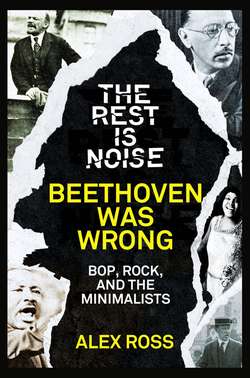Читать книгу The Rest Is Noise Series: Beethoven Was Wrong: Bop, Rock, and the Minimalists - Alex Ross - Страница 7
Bebop
ОглавлениеDuring the two-decade stretch from 1945 to 1965, when the minimalist composers were growing from childhood to maturity, American popular music exploded with creative energy. Jazz, blues, country, and gospel evolved into rhythm and blues, rock ’n’ roll, soul, and funk. Hank Williams, a white singer with an ear for the blues, crafted country songs of gem-like beauty; Ray Charles and James Brown fused gospel elation with blues sensuality; Chuck Berry let loose the stripped-down anarchy of rock ’n’ roll; Elvis Presley and the Beatles repackaged rock for a huge youth public.
For young American composers with open ears, the Cold War decades were, above all, the age of bebop and modern jazz. Dizzy Gillespie, Charlie Parker, Thelonious Monk, Miles Davis, John Coltrane, and Charles Mingus burst through the formal confines of swing and made music of ricocheting freedom and imperturbable cool. At the height of bop, electric strings of notes lashed around like downed power lines on wet pavement. Two sounds caught the ear of the fourteen-year-old Steve Reich: the punch-drunk rhythm of The Rite of Spring and the blindsiding beat of Kenny Clarke. Terry Riley was a bebop kid who later mastered ragtime piano. La Monte Young played excellent alto sax in his youth and probably could have had a major jazz career if he had wanted one. (When Young auditioned for a place in the top-notch Los Angeles City College jazz band, he beat out Eric Dolphy.) Philip Glass never played jazz, but listened avidly. The history of minimalism can’t be written without a cursory look at postwar jazz.
It was at the end of the Second World War that many young jazz players began to think of themselves as “serious musicians,” to quote Amiri Baraka’s classic book Blues People. Bebop, the poet said, articulated the self-esteem felt by hundreds of thousands of black soldiers as they returned home from the Second World War. When Parker inserted the opening notes of The Rite of Spring into “Salt Peanuts,” he was paying his respects while also declaring his freedom with a somewhat impudent air. You couldn’t dance to “Koko”; you had to sit back and listen as Parker scribbled lightning in the air. Monk threw in angular lines and dissonant chords, softening them with the elegance of his touch. Coltrane relished Bartók’s chords of fourths in the Concerto for Orchestra. “We had some fundamental background training in European harmony and music theory superimposed on our own knowledge from Afro-American musical tradition,” Gillespie wrote. “We invented our own way of getting from one place to the next.”
Ellington, in the twenties, had capitalized on the timbral possibilities of electrical recording. Bebop players took advantage of the next big advance, the long-playing record. The LP side allowed for the creation of half-composed, half-improvised works of mesmerizing breadth, the logical descendants of Black, Brown and Beige. In March 1959, Miles Davis released Kind of Blue, which put the brakes on bop’s forward drive. “So What,” the nine-minute opening track, is a proto-minimalist piece, defined by the dreamlike slowness of the harmonic rhythm. As the melodies drift by and change color, the underlying harmony stays fixed on a D-minor seventh chord, with periodic sidesteps into E-flat minor. Mingus, Coltrane, and Ornette Coleman also abandoned standard progressions in favor of a more open-ended tonal language. Their writing had much in common with the expanded tonality of Debussy, Stravinsky, and Messiaen. When Mingus explicated his “pedal point” style in the notes to his 1963 album The Black Saint and the Sinner Lady, he could have been paraphrasing Messiaen’s Technique of My Musical Language, with its schemes of multiple modes.
Jazz had entered its high-modern era, and assumed a modernist contempt for convention. Monk set the tone: “You play what you want, and let the public pick up what you are doing—even if it does take them fifteen, twenty years.” Miles Davis, in performance, turned his back to the crowd in Schoenbergian fashion. Bebop and dissonant composition drew close enough that there was talk of a merger. In the early sixties the composer and scholar Gunther Schuller propagated the idea of “Third Stream,” a confluence of jazz and classical energies. “It is a way of making music,” Schuller later wrote, “which holds that all musics are created equal, coexisting in a beautiful brother-hood/sisterhood of musics that complement and fructify each other.” Schuller brought in the likes of Coleman and Eric Dolphy to perform his brawny twelve-tone compositions, while Coleman asked Schuller for advice, notably while planning his epoch-making 1960 album Free Jazz. Anthony Braxton and Cecil Taylor, two other pioneers of free jazz, sounded like atonal composers in exile.
Even in its arcane phase, modern jazz hung on to its dynamism, its physical energy. That spirit proved irresistible to younger classical composers looking for a way out of Schoenberg’s maze. Jazz was intuitive, intimate, collaborative; it was serious in thought but playful in execution. Steve Reich remembers attending composition classes where students showed off byzantine scores whose intellectual underpinnings could be discussed ad nauseam. Then he’d go to see Coltrane play with his quartet. He liked the idea that Coltrane could walk out with a saxophone, play freewheeling improvisations on just one or two harmonies, and then disappear into the night. “The music just comes out,” Reich later said. “There’s no argument. There it is. This presented me with a human choice, almost an ethical, moral choice.”
